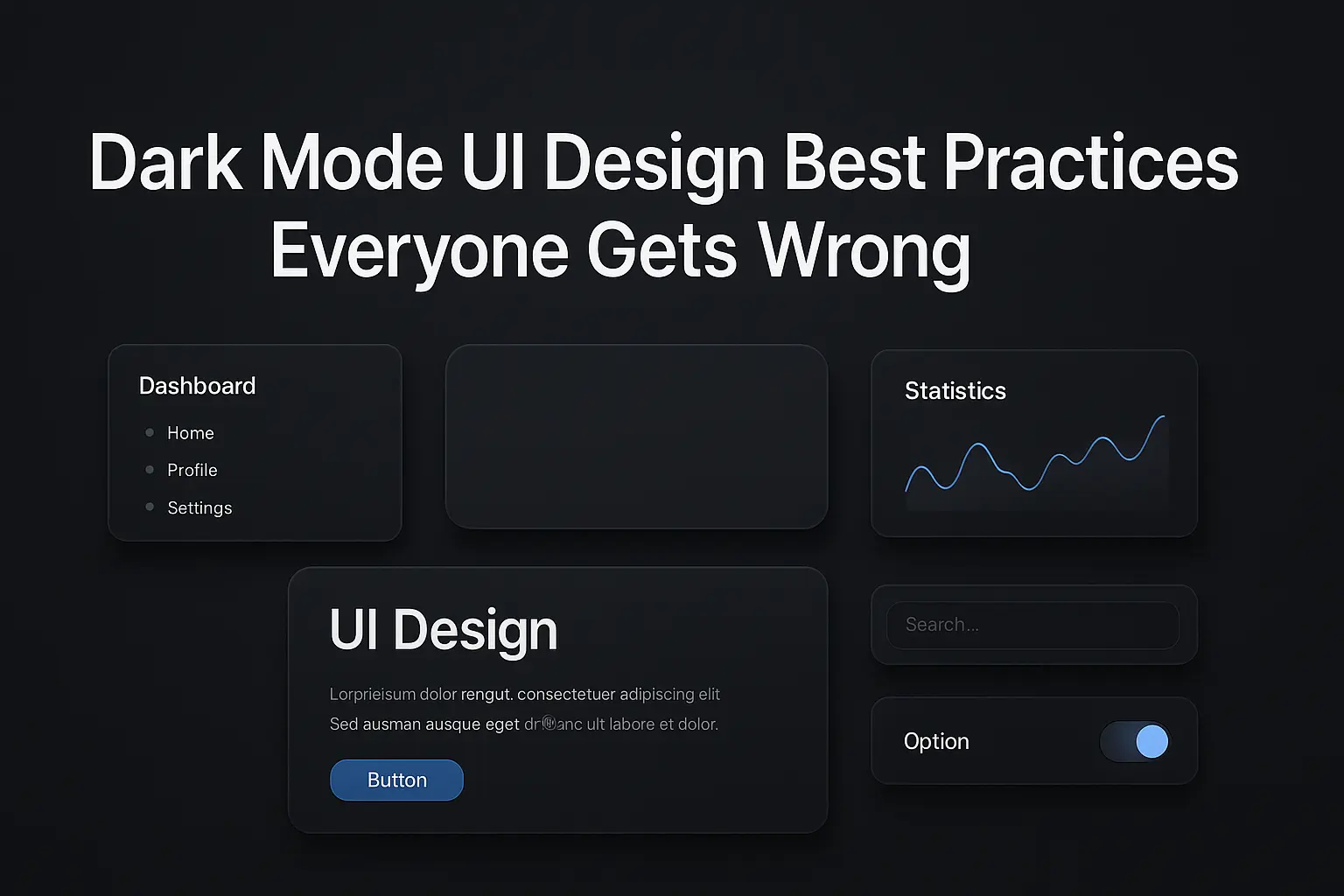
Introduction
You know what's funny? Almost every designer I know thinks they understand dark mode. They'll slap some gray backgrounds, throw in white text, and call it a day.
Then they wonder why users complain about eye strain, poor readability, and interfaces that just feel... off.
I've been there. I've made every mistake in the book when it comes to dark mode UI design best practices. And I'm going to save you from making the same ones.
If you're interested in learning more about modern UI/UX design principles and creating accessible interfaces, check out my other articles on responsive design and frontend development best practices.
In this guide, we'll explore:
Table Of Contents
- The Dark Mode Illusion We All Believe
- Why Everyone Loves Dark Mode (But Can't Explain Why)
- The Pure Black Mistake That's Killing Your Design
- Your Color Palette Is Probably Wrong Too
- The Typography Trap Nobody Warns You About
- Shadows Don't Work (So Stop Using Them)
- Creating Structure Without Losing Users
- Images and Icons Need Special Treatment
- Accessibility Isn't Optional (It's Essential)
- Making Interactions Feel Right
- Building a System That Actually Scales
- The Mistakes That Cost Me Users
- What Actually Works (Based on Real Data)
- Conclusion
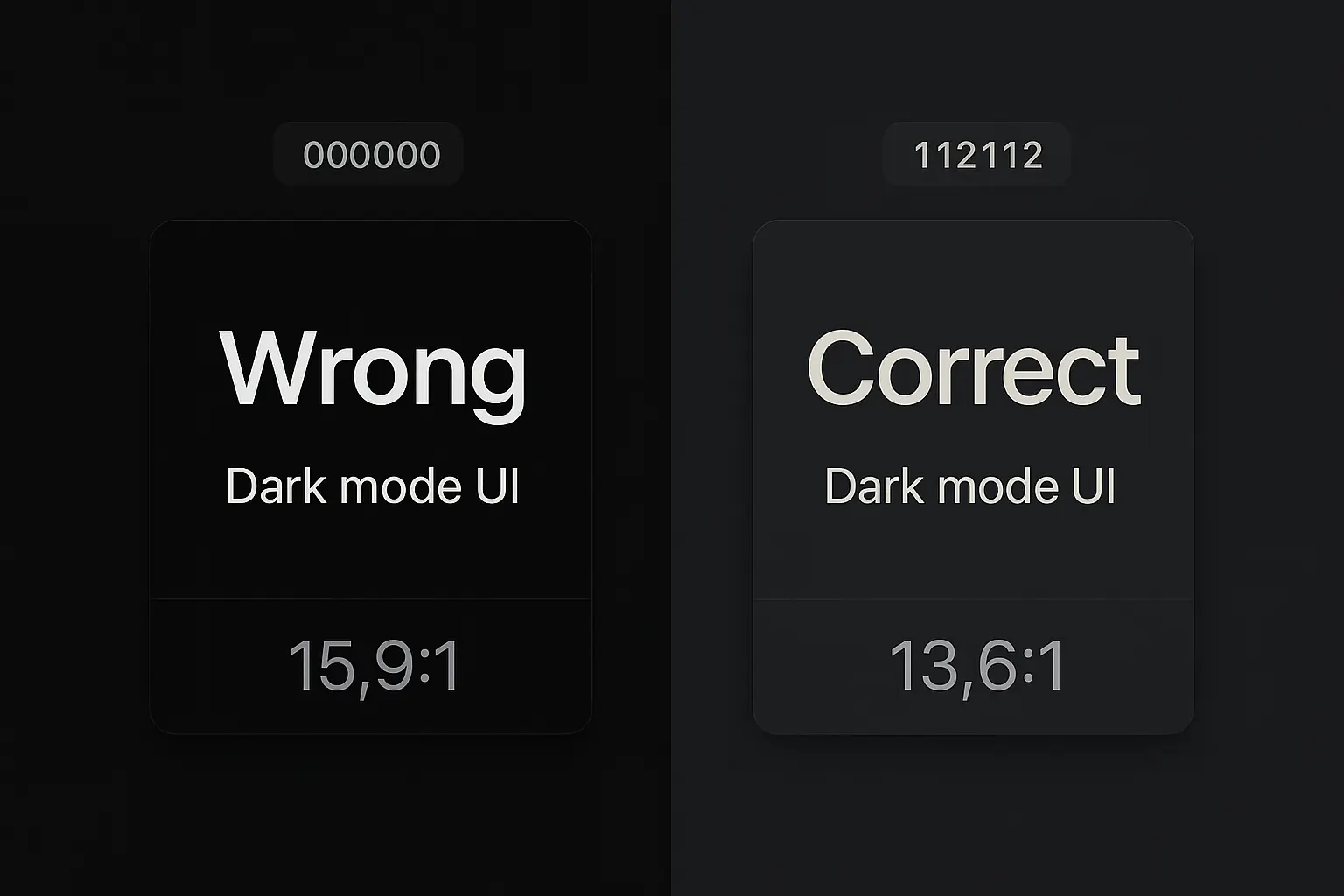
1. The Dark Mode Illusion We All Believe
Here's the uncomfortable truth: dark mode isn't just light mode with inverted colors.
When I first started designing dark interfaces, I thought it would be simple. Just flip the palette, right? Wrong. So incredibly wrong.
Dark mode UI is a completely different design language that requires rethinking everything you know about color theory, contrast, typography, and visual hierarchy. The apps you love—Twitter, YouTube, Discord—they didn't just reverse their colors. They rebuilt their entire visual system from scratch.
And that's exactly what you need to do.
The Real Challenge of Dark Mode UI Design
The problem is that most designers focus on making it look cool and forget about making it work well. They chase trends without understanding the fundamentals of dark mode UI design best practices.
Dark mode isn't about aesthetics alone. It's about creating experiences that users genuinely want to come back to. And trust me, getting it right makes all the difference between an interface that users tolerate and one they actively prefer.
2. Why Everyone Loves Dark Mode (But Can't Explain Why)
Let's talk about why dark mode has taken over the design world.
First, there's the eye comfort factor. When you're browsing at 2 AM (we've all been there), a bright white screen feels like staring into the sun. Dark mode reduces that harsh glare and makes extended screen time actually bearable.
Then there's the battery life benefit. If you're on an OLED or AMOLED screen, dark pixels literally turn off. Your phone's battery thanks you with extra hours of use.
The Psychology Behind Dark Interfaces
But here's the real reason people love it: it just feels premium. Modern. Sophisticated. There's a psychology to it that goes beyond functionality.
Dark theme design creates a sense of focus and immersion. It reduces visual noise and lets content take center stage. Users report feeling less overwhelmed by dark interfaces, especially when consuming media or reading long-form content.
The catch? Most designers focus on making it look cool and forget about making it work well. That's where dark mode UI design best practices become critical.
3. The Pure Black Mistake That's Killing Your Design
This is the biggest mistake I see everywhere. Ready?
Stop using pure black (#000000).
I know, I know. It sounds crazy. It's dark mode, right? But pure black creates something called halation—when bright text on pure black backgrounds causes a halo effect that strains your eyes.
The Science Behind Deep Grays
Your background should be a deep gray instead. I typically use #121212, #1E1E1E, or #2A2A2A. Google's Material Design team spent thousands of hours researching this, and they settled on #121212 as the optimal base.
The difference seems subtle on paper, but your users' eyes will absolutely notice. Trust me on this one. These deep grays provide enough contrast for readability while eliminating the harsh eye strain that pure black creates.
This is one of the most fundamental dark mode UI design best practices that separates amateur implementations from professional ones.
4. Your Color Palette Is Probably Wrong Too
Here's another mistake: using the same brand colors from your light mode.
Colors behave completely differently on dark surfaces. That vibrant blue (#007BFF) that looks perfect in light mode? It'll blind your users in dark mode.
I learned this the hard way. I once kept our bright red error messages the same across both themes. Users complained they were "screaming" at them. And they were right.
Creating Dark Mode Color Systems
The fix? Desaturate your colors by 20-30% for dark mode. Create separate color tokens for each theme. If your primary blue is #007BFF in light mode, try #4A9EFF in dark mode. Softer, easier on the eyes, still recognizable.
Your brand colors need adjustment for dark surfaces. This isn't about abandoning your brand identity—it's about adapting it for optimal readability and user comfort.
Contrast Ratios and WCAG Compliance
And please, please check your contrast ratios. The WCAG standard exists for good reason—aim for at least 4.5:1 for normal text and 3:1 for large text. Use tools like WebAIM's contrast checker. Your accessibility matters.
Proper contrast ratio isn't just about meeting standards. It's about ensuring every user can read your content comfortably, regardless of their viewing conditions or visual abilities.
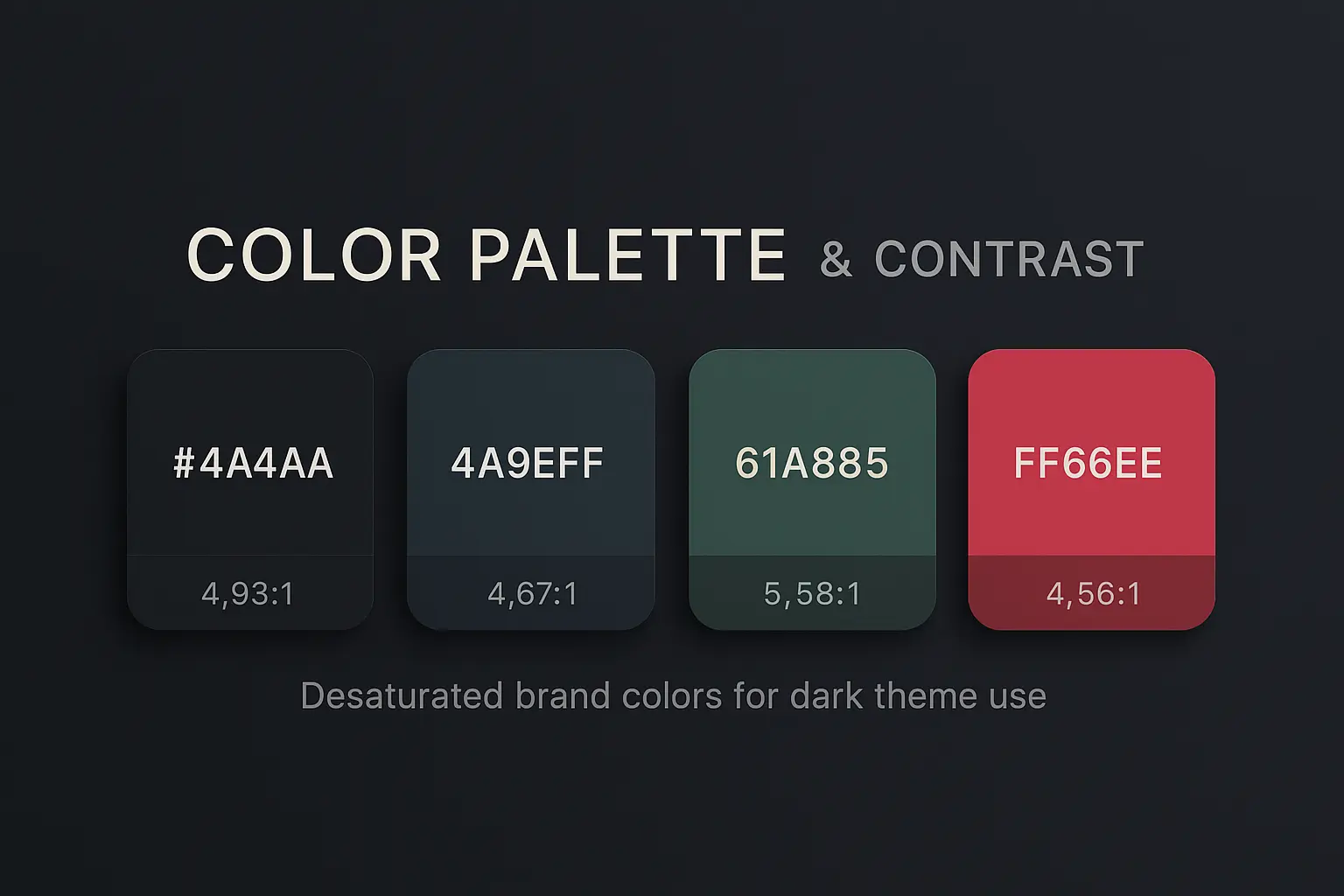
5. The Typography Trap Nobody Warns You About
Let me hit you with another truth bomb: never use pure white text (#FFFFFF).
I know it seems logical. Dark background, white text, maximum contrast. But maximum contrast isn't always good contrast.
Pure white on dark backgrounds is harsh and fatiguing. Instead, use off-white shades like #E0E0E0 or #F2F2F2. The difference is subtle, but it makes reading comfortable instead of exhausting.
Font Weight Considerations
Also, avoid thin or light font weights. They look elegant in light mode but become nearly invisible in dark mode. Stick with medium to semi-bold weights. Your text needs presence without being overpowering.
Typography best practices for dark mode require rethinking what you know about readability. The rules that work in light mode don't directly translate.
Spacing and Readability
I also increase line height slightly and add a bit more letter spacing in dark mode. Give your text room to breathe. Your users' eyes will thank you during those long reading sessions.
These micro-adjustments in typography create macro improvements in user experience. It's the kind of attention to detail that users don't consciously notice but definitely feel.
6. Shadows Don't Work (So Stop Using Them)
Here's where dark mode gets weird: traditional shadows don't work.
Think about it. In light mode, we use dark shadows to create depth. But in dark mode? Dark on dark just creates a muddy, confusing mess.
Understanding Light and Elevation
You need to think backwards. Instead of shadows, use subtle highlights and glows. Imagine how light actually works in darkness—objects don't cast dark shadows; they're illuminated by light sources.
Material Design has a clever solution: they elevate surfaces using lighter shades. The higher the element, the lighter it becomes. So a floating button might be #2A2A2A while your base is #121212.
Creating Depth Without Shadows
Gradients are your secret weapon here. A subtle gradient from #1E1E1E to #252525 creates depth without traditional shadows. It's the kind of detail users don't consciously notice but definitely feel.
This approach to creating visual hierarchy in dark interfaces is one of the most misunderstood aspects of dark mode UI design best practices. Master this, and your interfaces will immediately feel more polished.
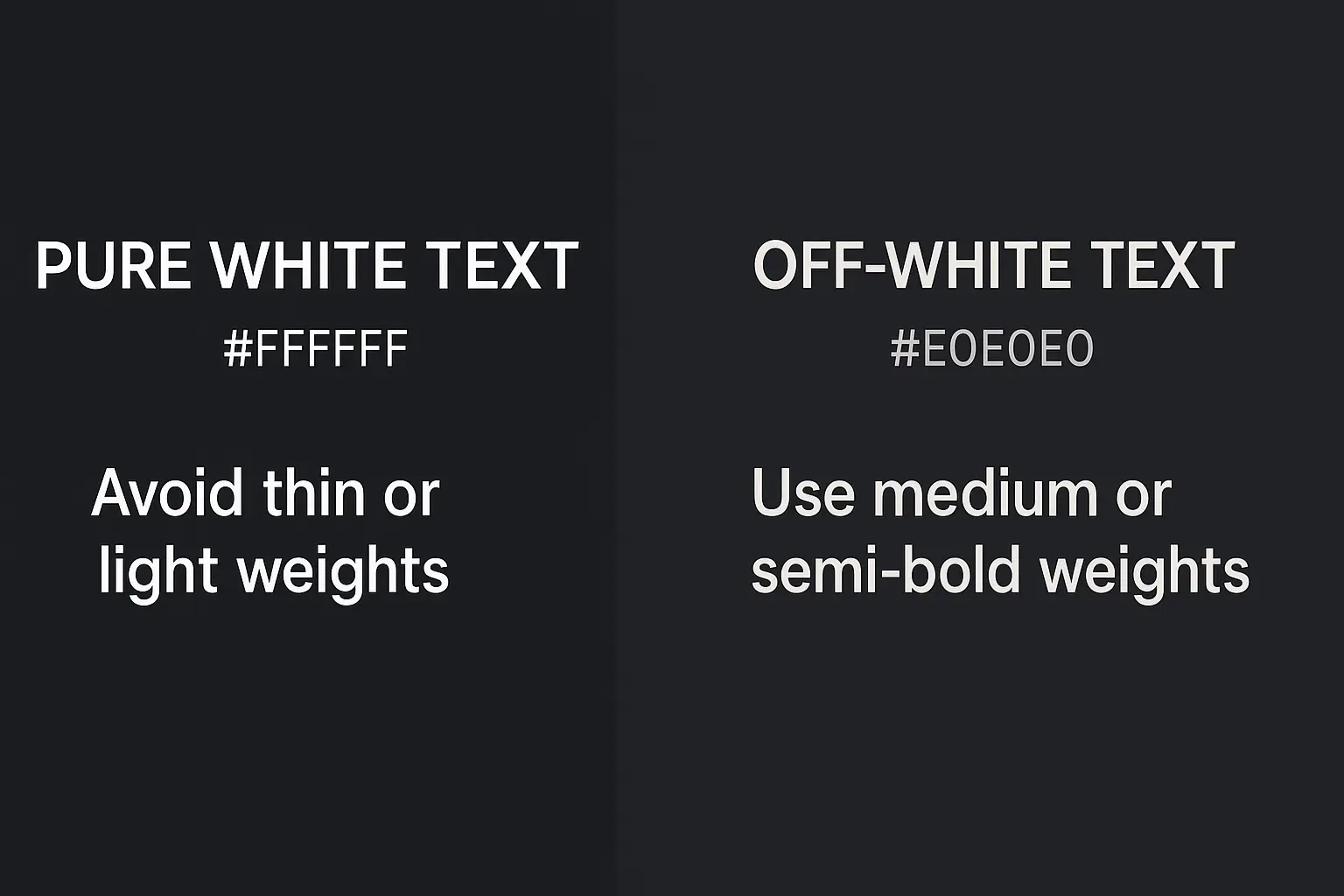
7. Creating Structure Without Losing Users
One of the worst dark mode designs I've seen? Everything was the same shade of dark gray.
No hierarchy. No structure. Just an endless void where users got lost trying to find buttons, cards, or any sense of organization.
Building Surface Levels
You need different surface levels. Think of it like architecture—different floors, different materials, different purposes.
Your base background might be #121212. Cards or panels could be #1E1E1E. Modals or elevated elements might be #2A2A2A. This creates visual separation without needing borders or shadows everywhere.
The goal? Users should instantly understand the structure of your interface just by looking at it. No confusion, no hunting for elements.
Visual Hierarchy in Dark Themes
Dark theme design requires intentional layering. Each surface level should have a clear purpose and relationship to other elements. This isn't just about aesthetics—it's about creating intuitive navigation patterns that users understand instinctively.
8. Images and Icons Need Special Treatment
Images can look washed out or disappear entirely on dark backgrounds. I've seen product photos that were invisible because they had dark backgrounds themselves.
Adding Visual Separation
Here's my solution: add subtle borders or glows. A 1px border using rgba(255,255,255,0.1) works wonders for separating images from the background.
For icons, you might need to create dual-color versions specifically for dark mode. What works in light mode might lose definition in dark mode. Test your icons at actual size, not zoomed in on your design canvas.
Handling User-Generated Content
And if you're working with user-generated content or photos? That's tricky. Sometimes I add a light backdrop behind images or use a subtle drop shadow with light color instead of dark.
The key is ensuring every visual element maintains its clarity and purpose, regardless of its original design context. This is especially important for UI imagery that needs to work across both light and dark interfaces.
9. Accessibility Isn't Optional (It's Essential)
Let's get serious for a moment. Dark mode UI design best practices aren't just about looking good—they're about being usable by everyone.
Your contrast ratios need to meet WCAG standards. Period. No exceptions.
Beyond Basic Compliance
But it goes deeper than that. Don't rely solely on color to convey information. Use icons, labels, and patterns too. Colorblind users need to navigate your interface just as easily as anyone else.
Keyboard focus indicators are crucial. In dark mode, I use a bright accent color like #4A9EFF for focus states. It needs to be immediately visible without being obnoxious.
User Control and Customization
Here's something I've started implementing: adjustable brightness controls. Even well-designed dark modes can be too bright for some users. Give them control over their experience.
Accessibility in dark mode isn't a checkbox exercise. It's about ensuring your interface works for users with diverse needs, abilities, and contexts. When you design with accessibility in mind, everyone benefits.
10. Making Interactions Feel Right
Hover states, active states, focus indicators—these need special attention in dark mode.
For hover effects, I lighten the surface by 5-10%. If your button is #1E1E1E, the hover state might be #282828. It's subtle but noticeable enough to provide feedback.
Interaction State Design
Active states should be more pronounced—maybe 15-20% lighter. And for selected items? Bring in your accent color at about 10-15% opacity as a background tint.
Ripple effects work beautifully in dark mode. Use light-colored ripples like rgba(255,255,255,0.1) for that smooth, responsive feel users expect from modern interfaces.
Consistency Across Interactions
The key is consistency. Every interaction should have clear visual feedback that follows the same logic across your entire interface. Users should never wonder whether their action registered or which element is currently active.
These UI interaction patterns create the micro-experiences that define how your interface feels. Get them right, and your dark mode will feel polished and professional.
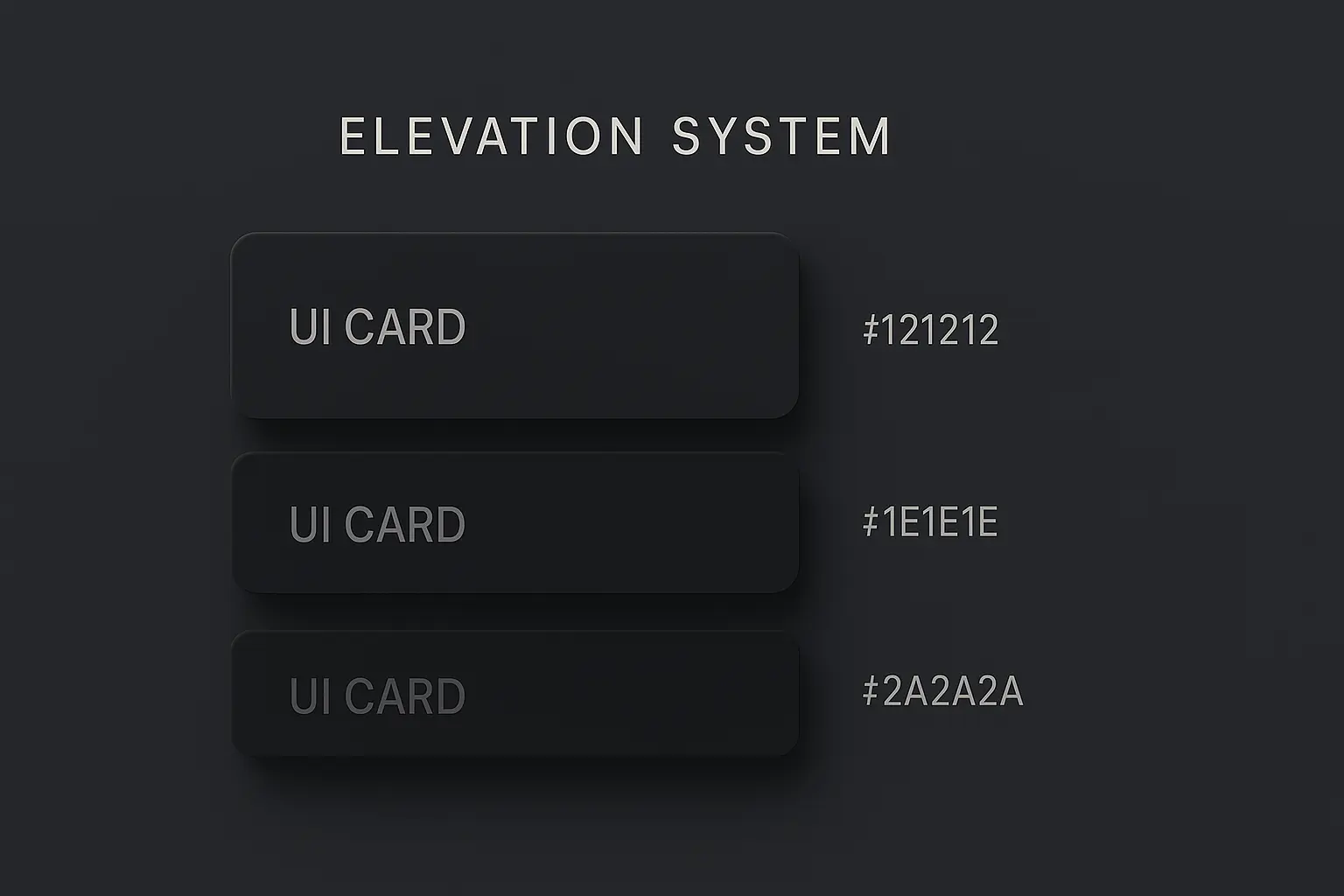
11. Building a System That Actually Scales
If you're serious about dark mode, you need a systematic approach. No more hardcoded colors scattered throughout your CSS.
CSS Variable System
Use CSS variables for everything:
:root {
--bg-primary: #121212;
--bg-secondary: #1E1E1E;
--bg-tertiary: #2A2A2A;
--text-primary: #E0E0E0;
--text-secondary: #A0A0A0;
--accent: #4A9EFF;
}
This makes switching themes trivial and maintaining your design system actually manageable. When you need to adjust colors, you change them in one place, not scattered across dozens of stylesheets.
Theme Toggle Implementation
For the toggle, keep it simple. A sun/moon icon works perfectly. Store the user's preference in local storage—forcing them to toggle every visit is terrible UX.
Better yet, detect their OS theme preference using the prefers-color-scheme media query. But always, always give them manual control. Some people want dark mode all the time, others only at night.
Modern Framework Support
Modern frameworks like Tailwind CSS make implementing dark mode UI design best practices easier with built-in dark mode utilities. But the principles remain the same regardless of your tech stack.
Building a proper theme system isn't just about convenience—it's about creating a maintainable codebase that scales as your product grows.
12. The Mistakes That Cost Me Users
Let me share the painful lessons I learned implementing dark mode across multiple projects.
Common Design Mistakes
Using oversaturated colors. Your bright red (#FF0000) will literally hurt to look at. Tone it down to something like #FF6B6B for dark mode.
Making everything high contrast. Not every element needs to scream for attention. Create hierarchy with varying contrast levels. Important elements can be brighter, secondary elements can be more subtle.
Testing and Context Issues
Forgetting about context. What looks perfect on your calibrated monitor at night might be unreadable on a phone in sunlight. Test in multiple environments.
Not testing on real devices. OLED displays dark mode differently than LCD screens. What looks great on your MacBook might look terrible on an Android phone. Always test on actual hardware.
Learning from Feedback
Ignoring user feedback. Your users will tell you when something's wrong. Listen to them. Some of my best dark mode improvements came from user complaints I initially dismissed.
These dark mode design mistakes are easy to make but costly to fix after launch. Learn from my pain and avoid them from the start.
13. What Actually Works (Based on Real Data)
After designing dozens of dark mode interfaces and analyzing user behavior, here's what I know works:
The Foundation
Start with #121212 as your base. Use 3-4 surface levels maximum. Keep your text at #E0E0E0 or lighter. Desaturate your brand colors by 20-30%. Test your contrast ratios religiously.
These fundamentals of dark mode UI design best practices create the foundation for everything else. Get these wrong, and no amount of polish will save your interface.
User Control and Preferences
Give users control. Auto-detect their preference but let them override it. Store their choice. Make switching themes instant and seamless.
Users appreciate when apps respect their preferences and remember their choices. This small detail significantly impacts user satisfaction and retention.
Iterative Testing
Test in different lighting conditions. What works in your dark office might fail in bright daylight. Context matters more than you think.
And most importantly: iterate based on real user feedback, not just design trends. Your analytics and user research will tell you what's actually working.
14. Conclusion
By following proper dark mode UI design best practices, you can create interfaces that users genuinely prefer over light mode alternatives. Dark mode isn't just a trendy feature—it's a complete design system that requires thoughtful implementation.
Here are the key takeaways for successful dark mode implementation:
- Avoid pure black: Use deep grays like #121212 for comfortable viewing
- Desaturate colors: Reduce brand color saturation by 20-30% for dark surfaces
- Use off-white text: #E0E0E0 instead of pure white prevents eye strain
- Create surface levels: Use 3-4 distinct shades to establish visual hierarchy
- Think light, not shadows: Use highlights and lighter surfaces for depth
- Test contrast ratios: Maintain WCAG standards with 4.5:1 minimum for text
- Build flexible systems: Use CSS variables and respect user preferences
- Prioritize accessibility: Design for everyone, not just average users
The question isn't whether you should implement dark mode—it's whether you'll do it right. Over 80% of users prefer dark mode for evening use, and many use it exclusively. Your interface needs to work beautifully in both themes.
When you master dark mode UI design best practices, you're not just adding a feature. You're respecting user preferences and creating experiences that work in every context.
Stop using pure black. Start building dark modes that users actually love.
Dark mode UI design best practices are essential for modern interface design. Start with deep grays, maintain proper contrast ratios, and build flexible theme systems. The constraints of dark mode don't limit creativity—they focus it on creating comfortable, accessible experiences that users prefer.
Ready to Implement This in Production?
Skip the months of development and debugging. Our team will implement this solution with enterprise-grade quality, security, and performance.